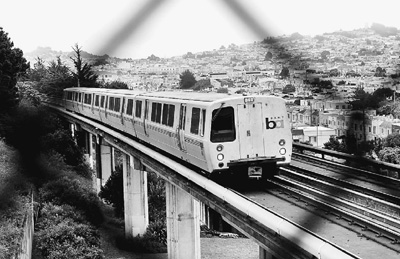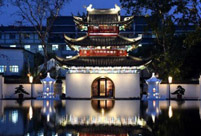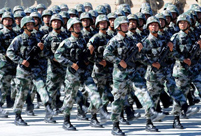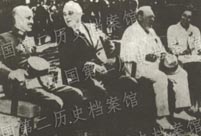 YOG kicks off in Nanjing
YOG kicks off in Nanjing
 Colorful life at Youth Olympic Village of Nanjing 2014 YOG
Colorful life at Youth Olympic Village of Nanjing 2014 YOG
 Royal Taoist temple to open to public
Royal Taoist temple to open to public
 Female soldiers at quake-hit area
Female soldiers at quake-hit area
 Shocking photos of cruel battles in Ukraine
Shocking photos of cruel battles in Ukraine
 Amphibious armored vehicle unit conducts open sea drill
Amphibious armored vehicle unit conducts open sea drill
 Water relay in Henan
Water relay in Henan
 Ethnic culture feasts eyes of travelers
Ethnic culture feasts eyes of travelers
 80 security dogs assembled in Nanjing police dog training base
80 security dogs assembled in Nanjing police dog training base
 Graffiti artists paint on street walls in Xinjiang
Graffiti artists paint on street walls in Xinjiang
 |
| A train traveling on a viaduct near San Francisco in the United States. (Photo/People’s Daily) |
U.S. President Barack Obama put forward an ambitious high-speed rail plan when he first took office. In reality no progress has been made during his six years in office. "High-speed rail was supposed to be President Obama’s signature transportation project," says the New York Times, "but the projects have gone mostly nowhere and the United States still lags far behind Europe and China. "
American dreams of high-speed rail are growing stronger, especially when they witness the revolutionary effect of high-speed rail on the national economy and everyday life in China and Europe. President Barack Obama planned to build a transcontinental high-speed rail line. The shiny bullet-shape trains would gallop between different cities in the United States at a maximum speed of more than 320 kilometers per hour. Eighty percent of Americans would enjoy access to high-speed rail within twenty-five years.
In reality, the rail transport network in the US is terrible. On one occasion when a reporter had to make an unplanned trip from Washington to Boston, the expected six to seven hour journey turned into thirteen hours because of heavy rain. In contrast, an American lawyer in China on business, was highly impressed by his first experience of high-speed rail, and astonished by China’s rapid development.
Both the President and the ordinary people of the U.S. share a dream of high-speed rail. But the dream has become a victim of government gridlock and party strife. In 2011 US Vice President Joe Biden, a high-speed rail supporter, announced a plan to build a high-speed rail network costing $53 billion over a period of six years. Even Time Magazine, a supporter of the plan, concedes that it has "gone nowhere".
When the Republicans gained control of the U.S. House of Representatives, they withdrew support for the plan. Endless legal and political disputes have meant that the project had not yet started. Other republican governors have also subsequently cancelled elements of the project, thinking it too expensive and unnecessary.
Some critics have argued that while in theory the plan was sound, in reality it was time-consuming, land-hungry, and not cost-effective. Commentators have pointed out that while high-speed rail might run smoothly in Asia and Europe, it may not be suitable for the United States with its relatively vast territory and sparse population. Robert Puentes, senior fellow, Brookings Institution’s Metropolitan Policy Program, claims that there are many serious problems confronting the United States, such as political and economic barriers, and issues of environmental protection. These explain why the high-speed rail construction project has made such slow progress. In his opinion, the government should undertake smart investment, strategically building one or two high-speed rail lines.
The article is edited and translated from《美国“高铁梦”成了“世界笑话”(国际视点)》, source: People.com.cn, author: Wu Chengliang
 Special holidays
Special holidays World's top 10 fighters
World's top 10 fighters 'Stewardesses' serve in hospital
'Stewardesses' serve in hospital Beautiful night scenery of Nanjing
Beautiful night scenery of Nanjing ‘Peace Mission -2014’ joint anti-terror military exercise kicks off in China
‘Peace Mission -2014’ joint anti-terror military exercise kicks off in China Eye-catching guides at the opening ceremony of YOG in Nanjing
Eye-catching guides at the opening ceremony of YOG in Nanjing A female missile launch company of PLA
A female missile launch company of PLA China, the U.S., Britain and the Soviet Union call for Japan's unconditional surrender
China, the U.S., Britain and the Soviet Union call for Japan's unconditional surrender Photo story: How a baby panda grows up
Photo story: How a baby panda grows up Star-leveled nursing home in a small county
Star-leveled nursing home in a small county Evidence of monstrous crime of Japanese invaders
Evidence of monstrous crime of Japanese invaders Foreign models compete with Chinese in Cheongsam show
Foreign models compete with Chinese in Cheongsam show The beautiful pictures of ancient Chinese architecture
The beautiful pictures of ancient Chinese architecture The Muslims involved in relief work
The Muslims involved in relief workDay|Week|Month